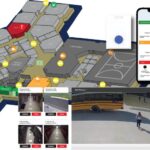When campuses are evaluating an IP video management system (VMS), a key mission is to ensure the software’s features not only meet their needs but are easy to use as well. In many cases, a VMS has more functional elements than are sometimes ever used by the customer, rendering the system more complicated to use.
Within recent years there has been an increased focus in the market on not just which features are included in a video surveillance system, but also how practical these various system applications are for the end user. Previously customers were mainly comparing the list of features when evaluating competing surveillance systems. This superficial approach is changing, and it is a sign the market is maturing.
Consider These 3 Fundamentals
Today end users are increasingly aware that an optimal return on their investment not only depends on the price of the product, but also on additional costs like training of employees and support calls. Consider these fundamentals:
- Return on investment (ROI) means getting the most out of the security system investment over the longest period of time possible. Is the system scalable, flexible and able to be integrated with other systems and multiple brands of devices? In other words, is it open platform and future-proof?
- Training costs will relate to the ease-of-use with the surveillance system. The less training needed to operate the system, the more efficient the customer can be in operating the system — especially if there is a lot of personnel turnover. Integrators should provide customers with an interface that is available in multiple languages and adapts to different skill levels for each user, individually or in groups.
- Because unnecessary features can make a system exceedingly complex, integrators should provide tiered product offerings that allow an end user to select the level of software that best suits their needs. This allows for system upgrades over time as needs evolve and expand.
Executing Design and Implementation Factors
What can campuses do to make certain that the video surveillance system they purchase is designed in a way to fit how their tasks are organized? This can be accomplished by being as specific as possible when listing the organization’s primary tasks. Following is a short set of guidelines for evaluating the usability of video surveillance systems.
Draft a prioritized list of functions the campus plans to do with the video surveillance solution — Will the system be used primarily for investigating incidents after they have happened? If so, prioritize tasks such as finding camera views, navigating between recorded sequences, bookmarking sequences for further investigation (these may be performed by different users, so support for collaboration will be important), and sharing them with external authorities, which is typically in the form of exported video. How easy are these tasks to perform with the considered VMS offerings?
Sometimes users know what to look for when investigating video sequences because a certain incident has occurred at a certain time and place. Other times the investigation is more open-ended, for example, when reviewing video to see what has happened in a specific building during the weekend. In both cases you are searching for video recordings, but the needs are quite different.
In the first case, users need to find recordings from a single or small group of cameras. In the second example, users need to find and view recordings from a potentially large group of cameras where motion has been detected from, say, Friday afternoon to Monday morning. Do the systems being evaluated support both types of tasks in a quick and efficient manner? For live video monitoring, users typically need to watch views from multiple cameras or even camera groups, all at the same time, and be able to quickly switch focus from one camera image to another. If some of the cameras are pan/tilt/zoom (p/t/z) models, consider if controlling them is preferred using a mouse and keyboard or a joystick.
Even if the system will be used primarily for live monitoring, there is still the need to investigate recorded video. While viewing live video, operators may notice a bag lying near a bench, for example, and need to find the person who left the bag unattended. How easy is it to perform such an investigation into the recorded video while still keeping an eye on the area being monitored with the live video? If there are too many activities going on to perform such an ad hoc investigation, does the system allow bookmarking the video for later investigation or even delegate the investigation to someone else?
No matter how the system will be used, don’t forget to think about the administrative tasks for maintaining and even extending the system. These tasks include deleting or adding a new camera or user. Monitoring the health of the entire surveillance system is necessary to avoid a breakdown at a critical moment. Typical end users don’t want to monitor the system 24/7, so a notification or alert function is needed when something like recording server disk space is reaching a critical level.













